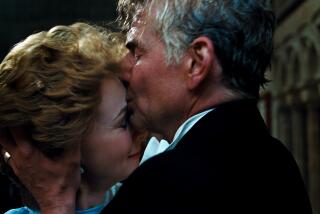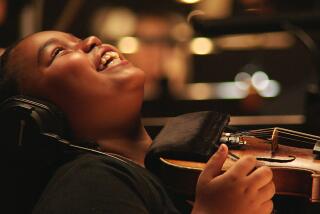‘A Late Quartet’ actress gets coached in finer points of playing viola
Having a Hollywood actor learn Beethoven’s String Quartet No. 14 for a role is a little like asking a child to master differential equations — it’s virtually impossible. But in the case of music, the task can be convincingly faked with the right editing, and more important, with the right music coaches.
When the makers of the movie “A Late Quartet” were looking for a musician who could help actress Catherine Keener get into character as a classical viola player, they sought the help of Carrie Dennis, the Los Angeles Philharmonic’s principal violist, who joined the orchestra in 2008.
Dennis said that she spent two weeks hanging out with the Oscar-nominated actress in late 2010 before filming began. She said Keener attended rehearsals and the two spent time together at the actress’ home in Santa Monica.
‘THE SOLOIST’: Steve Lopez columns on Nathaniel Ayers
“She wanted the mannerisms and subtleties of how you hold the instrument when you’re just hanging out and talking,” recalled Dennis.
“A Late Quartet,” now in limited release, follows the emotional upheavals of a fictional New York string quartet played by Keener, Philip Seymour Hoffman, Christopher Walken and Mark Ivanir.
When the quartet’s eldest member, a cellist played by Walken, announces his decision to retire following a diagnosis of Parkinson’s disease, the other players must decide whether the ensemble will continue.
PHOTOS: Arts and culture in pictures by The Times
The cast learned to mimic playing their instruments in front of the camera, while the actual music heard on the movie’s soundtrack was performed by the Brentano String Quartet, a New York ensemble.
To help Keener get some of the details right, Dennis advised her on things that ordinary viewers might not even notice, such as the way musicians handle expensive instruments, which can easily cost in the millions of dollars.
“Everyone is very uptight about their instruments,” Dennis said.
She also taught Keener about the small bruise that most professional violin and viola players have on the left side of their necks that comes from hours of playing.
Before joining the L.A. Philharmonic, Dennis had experience playing in string quartets. “It’s like being married to three people,” she said. “There is no separation — you have to be emotionally vulnerable and comfortable with everyone else.”
Dennis, who lives in Hollywood with her husband and two toddler sons, started her music career as a violinist before gradually switching to the viola in her teens. She said violists tend to have a different temperament than violinists.
“Violists are more laid back generally — way more laid back,” she explained. “We have to know how not to be scared to be in the limelight for a moment, and to then step back and let others be in the limelight.”
The production enlisted personal coaches for each of the actors and arranged for them to observe famous ensembles, such as the Takács Quartet and Tokyo String Quartet, according to director Yaron Zilberman.
He said Hoffman, whose character plays the second violin, had two coaches and that Walken had three. Keener, who was not available for an interview, was coached by violist Jerome Gordon, in addition to Dennis.
Zilberman, who co-wrote the screenplay with Seth Grossman, based the fictional quartet on a few real-life ensembles, but the strongest resemblance is to the Guarneri Quartet, whose founding cellist David Soyer was its eldest member and who left the group in 2002.
The director said the internal fights portrayed in the movie are not so far from reality. “Some quartets are like dysfunctional families,” he said.
Zilberman said he heard that members of the Budapest String Quartet were on such bad terms with each other that they once requested to stay in separate hotels during a visit to Los Angeles.
He said a member of the Alban Berg String Quartet used to fax fingerings to his colleagues because they didn’t speak to each other.
“A Late Quartet” features extended passages from Beethoven’s String Quartet No. 14, Op. 131, which is regarded as one of the most challenging pieces a string ensemble can perform.
The piece features seven sections that are often played without a break.
“It’s an extremely interior and spiritual piece. It’s extremely dramatic — it almost begs to be put into scenes,” said Misha Amory, a violist with the Brentano String Quartet.
He said the quartet made a DVD for the cast in which they performed sections of the piece so that the actors could learn the necessary movements.
“A Late Quartet” has received mixed reviews since being released last week. Movies about string quartets are rare — a 1983 Italian movie called “The Basileus Quartet” is one example. More recently, Michael Hollinger’s stage play “Opus” focuses on members of a fictional string ensemble performing the same Beethoven composition.
“A Late Quartet” isn’t the first movie on which an L.A. Philharmonic musician has worked as an adviser. Cellist Ben Hong coached actor Jamie Foxx on “The Soloist,” the 2009 film based on a book by Los Angeles Times columnist Steve Lopez.
Dennis said she hasn’t seen “A Late Quartet” yet but hopes to soon. She pointed out a minor mistake in the movie’s poster that shows Keener crossing her legs while performing.
“That is not something we normally do,” she said.
MORE:
CRITIC’S PICKS: Fall Arts Preview
TIMELINE: John Cage’s Los Angeles
PHOTOS: Arts and culture in pictures
More to Read
The biggest entertainment stories
Get our big stories about Hollywood, film, television, music, arts, culture and more right in your inbox as soon as they publish.
You may occasionally receive promotional content from the Los Angeles Times.







